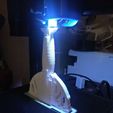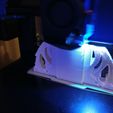E1:210º E1:210º E1:210º E1:210º E1:210º E1:210
Bed:40º E1:40º Bed:40º Bed:40º Bed:40º Bed:40
I've used PLA 870 filament and applied a heat treatment to increase the strength and make it withstand the bumps of a child.
It's been printed in PLA 870 and applied thermal curing in order to make it stronger, as it has been printed for a 4yo kid.
*Oven process - Oven process
These are the main points to be able to use our oven of
house.
Let's remember that, unless it is a very high quality oven, traditional ovens have
a temperature variation of between 20 and 40 degrees during the on and off phases, so that
ALWAYS use the lowest temperature available to you because it is the most stable one
(50-60 degrees Celsius)
NEVER use the ventilation system (or convection oven), ALWAYS use the oven.
traditional with upper and lower heating elements.
We will put the piece with the printer glass in the oven off and we will allow the oven to
warm up. We will start counting the minutes as soon as the oven has reached the
desired temperature.
Once the tempering time has elapsed, allow the piece to cool for a few minutes.
minutes, opening the oven door a little (the longer we leave the piece, the more we are sure that it will cool down).
that the piece will cool down progressively and that the innermost part of the piece will cool down progressively.
part is cold, and thus we will avoid leaving traces or deforming our project).
Once cold, we can separate the supports and the piece from the glass base.
These are the main points to use the oven of our kitchen.
Remember that, unless it is a very high quality oven, traditional ovens have a temperature variation
between 20 and 40 degrees between the on and of phases, so ALWAYS use the lowest
temperature available because it is the most stable (50-60 degrees Celsius)
NEVER use the ventilation system (or oven with convection), ALWAYS use the traditional oven with
upper and lower heating elements.
We will put the piece with the glass of the printer inside the oven still of and we will let the oven
warm up. We will start counting the minutes when the oven has reached the desired temperature.
Once the tempering time is over, let the piece cool down for a few minutes by opening the oven
door a bit (the more we leave the piece, the more sure we will be that the piece will gradually cool down
down and that the inner part of the piece is cold, and thus avoid leaving traces or deform our
project).
Once cool, we can separate the supports and the piece from the glass base.
Water method
Water process
The water method is usually the easiest and safest method since we have better control of the
tempering temperature.
We will fill our container with water and carefully measure the temperature.
In this case we will use a household thermometer to measure the water temperature.
around 70 degrees.
We proceed to immerse the piece with the glass base in our container, paying attention to
that the workpiece is completely submerged (if the workpiece has a very low percentage of filler,
will tend to float. For this reason, we will use some weights to make our project stay on the bottom
of the container, being careful that the weights don't touch the part).
Wait until the water is cold (less than 20 degrees) and proceed to separate the supports
and the piece of the glass base.
The method with water is usually the easiest and the safest since we have a better control of the
tempering temperature.
We will fill our water container by carefully measuring the temperature.
In this case we will use a home thermometer to measure the water temperature around 70 degrees.
We proceed to submerge the piece with the glass bed in our container, paying attention that the
piece is totally submerged (if the piece has a very low fill percentage, it will tend to float. For this we
will use some weights to help out project to stay at the bottom of the container, taking care that the
weights do not touch the piece).
Wait until the water is cool (less than 20 degrees) and proceed to separate the supports and the
piece from the glass bed.

/https://fbi.cults3d.com/uploaders/17364137/illustration-file/23744df7-c70d-4913-a203-5c4a47ce5dff/tizona_extendida.png)












